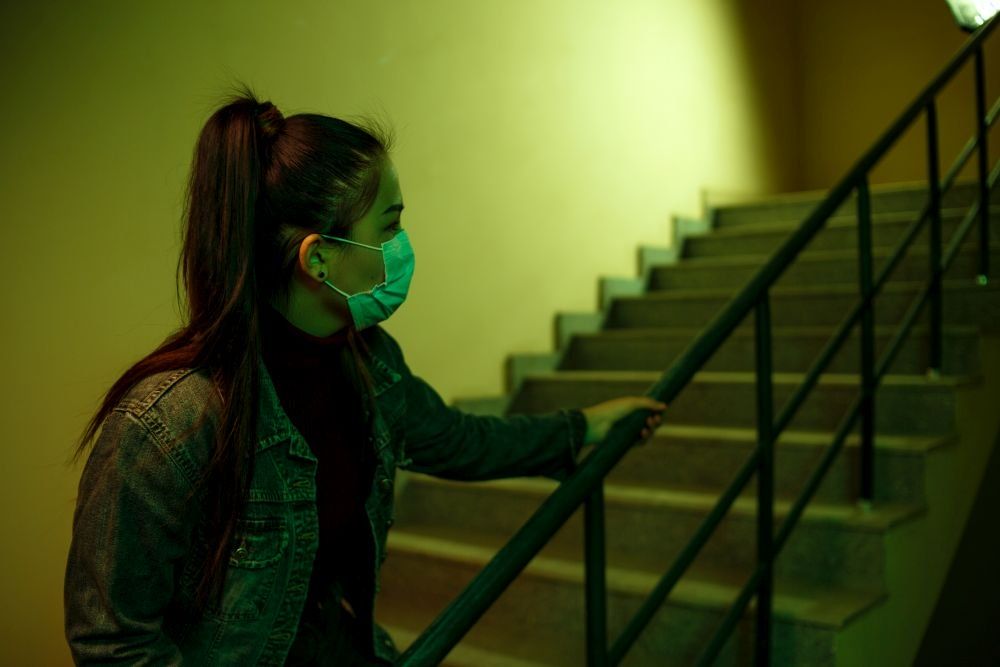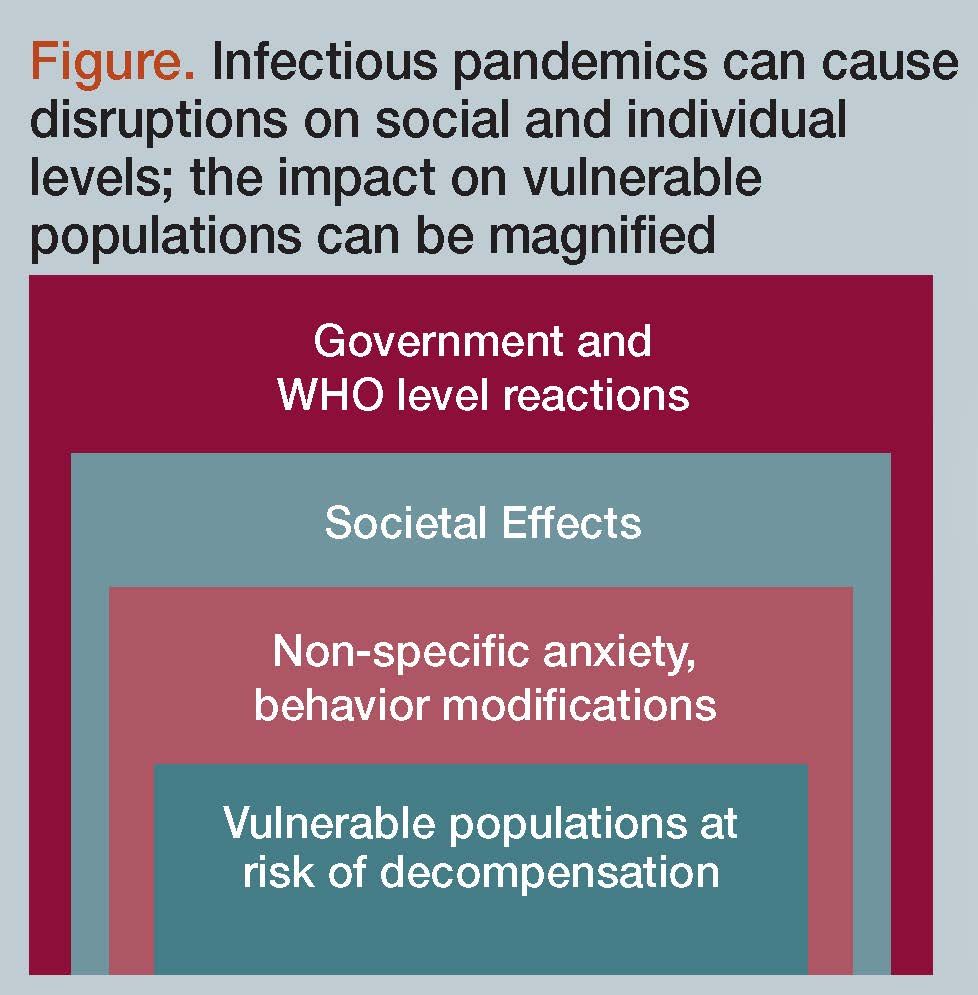
Publication
Article
Psychiatric Times
Psychiatrists Beware! The Impact of COVID-19 and Pandemics on Mental Health
Author(s):
Psychiatrists are uniquely situated to help both their patients and the greater community understand the potential impact of the virus and help patients, families, and society deal with this latest threat.

Nidal Moukaddam, MD, PhD

Asim Shah, MD

Figure. Infectious pandemics can cause disruptions on social and individual levels; the impact on vulnerable populations can be magnified

ANXIETY AND STRESS DISORDERS
It’s easy to blame, it’s easy to politicize, it’s harder to tackle a problem together and find solutions together.
WHO Director-General Tedros Adhanom Ghebreyesus, PhD, MSc
Infectious pandemics and the spread of organisms across countries and continents have been facilitated by global changes in earth’s climate and an increase in travel and international exchange. COVID-19, the infection caused by the novel coronavirus detected in December 2019, is now affecting more than 27 countries, raising concerns of widespread panic and increasing anxiety in individuals subjected to the (real or perceived) threat of the virus. Importantly, these concerns arise with all infections, including the flu and other agents, and the same universal precautions are needed and indicated for safety and the prevention of further transmission. However, media coverage has highlighted COVID-19 as a unique threat, rather than one of many, which has added to panic, stress, and the potential for hysteria.
Pandemics are not just a medical phenomenon; they affect individuals and society on many levels, causing disruptions. Stigma and xenophobia are two aspects of the societal impact of pandemic infectious outbreaks. Panic and stress have also been linked to outbreaks. As concerns over the perceived threat grow, people may start to collect (and hoard) masks and other medical supplies. This is often followed by anxiety-related behaviors, sleep disturbances, and overall lower perceived state of health. Individuals with mental illness may be particularly vulnerable to the effects of widespread panic and threat.
Related content: Fears, Outbreaks, and Pandemics: Lessons Learned
Chronic disease, including chronic infectious diseases such as tuberculosis and human immunodeficiency virus (HIV), are associated with higher levels of mental disorders as compared with the general population.1,2 Studies show depression rates usually soar after infections (eg, herpes exposure and anthrax scares).3,4 Although the effects of the coronavirus on mental health have not been systematically studied, it is anticipated that COVID-19 will have rippling effects, especially based on current public reactions. Psychiatrists are uniquely situated to help both their patients and the greater community understand the potential impact of the virus and help patients, families, and society deal with this latest threat.
Stigma, medical mistrust, and conspiracies
Epidemics lead to stigmatization of affected individuals, authority figures, and health care professionals; sadly, this trend has been seen in multiple countries and with multiple infectious agents.5 With COVID-19, men and women of Asian descent, specifically Chinese, are the victims of social stigma and xenophobia, with high levels of politicization and threats online and in personal interactions. As with most stigma-laden interactions, the process unfolds because of limited information, hasty and uni-dimensional assessments, and a defensive formulaic response. It is imperative that all health care professionals, especially psychiatrists, act as the voice of reason and help disseminate proper, evidence-based information.
“Medical mistrust” refers to a lack of trust in medical treatment and advances. It results in a lower use of health care resources and poorer management of health conditions (coupled with potential misuse at times of crisis). Moreover, medical mistrust has been used to explain some racial and ethnic health care disparities.6 It has been linked to a variety of diseases and conditions, including cancer, autism, and HIV.
During infectious pandemic,s medical mistrust has been linked to conspiracy theories. In one US study, up to half of those surveyed endorsed belief in at least one health-related conspiracy theory.7 At its extreme, medical mistrust can lead to movements such as anti-vaccination trends, which have been linked to measles outbreaks.8
Mistrust of medical organizations can reinforce stigma and perceived discrimination and result in lower adherence to health recommendations. Clinicians must maintain a scientific, fact-based, and neutral presentation of recommendations while emphasizing the importance of overall infection control practices in the wake of COVID-19.
Anxiety and obsessive-compulsive disorders
We anticipate the effects of infectious disease threats to manifest as sheer anxiety and panic: worry about getting an infection, worry about loved ones getting ill, and worry when related symptoms-even minor-are present. The absence of a definitive treatment for coronavirus easily exacerbates anxiety. In most cases, these anxiety symptoms do not reach diagnostic thresholds for a DSM-5 diagnosis; however, patients will benefit from reassurance and education.
Contamination obsessions-unwanted, intrusive worry that one is dirty and in need of washing, cleaning, or sterilizing-are very common in patients with OCD. Perceptual experiences (eg, feeling dirt on skin) understandably would amplify obsessions. Sensory experiences (but not necessarily full tactile hallucinations) have been found in up to 75 % of patients with OCD patients.9 More intense sensory experiences (pseudo-hallucinations) are related to worsened control over compulsions and poorer insight.10 Biased information processing is associated with a tendency to overestimate threat in individuals with OCD.11 This may increase sensitivity to the panic associated with pandemic threats and further destabilize patients and increase functional impairment.
Cleaning and washing compulsions, also a core feature of OCD, can easily be exacerbated by the threat of infectious pandemics. Complications of excessive cleaning include dry, chapped skin (which can lead to super-imposed infections). and contact and atopic dermatitis; similarly, overuse of toxic cleaning supplies can lead to inhalational injuries.12,13 Fear of acquiring a new, sensationalized disease may worsen negative behaviors. Clinicians in psychiatry, psycho-dermatology, and primary care practices should be alert to potential issues in patients with OCD.
Psychotic disorders: an extreme of medical mistrust?
Anecdotally, the most glaring (and maybe the most interesting) examples of medical mistrust conspiracy theories concern patients who have psychotic disorders. Typically, repeated media exposure to an alarming fact (in this case, spread of coronavirus), coupled with a distrust of organizations and government as well as misattribution of physical symptoms can result in delusions. Similarly, fears can quickly lead to clinical decompensation and must be carefully monitored.
Adding fuel to the fire are discussions of conspiracy theories related to infectious outbreaks such as HIV and Ebola in the mainstream media.14-16 The lack of knowledge about epidemics, the increase of zoonotic infections, and the fairly complex effects of climate changes can affect patients as well as confuse even an overall healthy person.
At the intersection of psychosis and obsessiveness is delusional parasitosis, also referred to as monosymptomatic hypochondrial psychosis, Ekbom syndrome, and delusional infestation. Essentially, the patient believes that he is infected with an organism that evades detection and treatment and, thus, causes continuous suffering. This syndrome was described as early as 1636 by sir Thomas Browne, who referred to it as Morgellons disease.17 A concerning clinical feature of delusional infestation is its occurrence in multiple family members (eg, folie a deux).18
Delusional infestation development in the context of pandemics has not been studied. Conceivably, increased cases may develop as more individuals focus on far-fetched, unlikely infections because of easy access to unverified information on the internet. To address delusional parasitosis, clinicians should rule out organic causes and reassure the patient that there is no infection or infestation.
Conclusions
The current COVID-19 outbreak is spurring fear on a societal level. On an individual level, it may differentially exacerbate anxiety and psychosis-like symptoms as well as lead to non-specific mental issues (eg, mood problems, sleep issues, phobia-like behaviors, panic-like symptoms). We urge our colleagues to spread sound infection control practices and help their communities maintain civil, courteous, and rational communication. A low index of suspicion of mental distress can help in early detection and treatment and spare patients much suffering.
Disclosures:
Dr Moukaddam is Associate Professor, Menninger Department of Psychiatry and Behavioral Science, Baylor College of Medicine, Ben Taub Adult Outpatient Services Director, Medical Director, STAR (Stabilization, Treatment, and Rehabilitation) Program for Psychosis, Houston, TX. Dr Shah is Professor & Executive Vice Chair, Barbara & Corbin J. Robertson Jr. Chair in Psychiatry at Menninger, Chief of the Division of Community Psychiatry at Baylor College of Medicine. They report no conflicts of interest concerning the subject matter of this article.
References:
1. van den Heuvel L, Chishinga N, Kinyanda E, et al. Frequency and correlates of anxiety and mood disorders among TB- and HIV-infected Zambians. AIDS Care. 2013;25:1527-1535.
2. Kuan V, Denaxas S, Gonzalez-Izquierdo A, et al. A chronological map of 308 physical and mental health conditions from 4 million individuals in the English National Health Service. Lancet Digital Health. 2019;1:e63-e77.
3. Gale SD, Berrett AN, Erickson LD, et al. Association between virus exposure and depression in US adults. Psychiatry Res. 2018;261:73-79.
4. Mason BW, Lyons RA. Acute psychological effects of suspected bioterrorism. J Epidemiol Comm Health. 2003;57:353-354.
5. Shigemura J, Ursano RJ, Morganstein JC, et al. Public responses to the novel 2019 coronavirus (2019-nCoV) in Japan: mental health consequences and target populations. Psychiatry Clin Neurosci. February 2020; Epub ahead of print.
6. Jaiswal J, Halkitis PN. Towards a more inclusive and dynamic understanding of medical mistrust informed by science. Behav Med. 2019;45:79-85.
7. Oliver JE, Wood T. Medical conspiracy theories and health behaviors in the United States. JAMA Intern Med. 2014;174:817-818.
8. Gaillat J. Vaccine hesitancy: how to lift the brake? [in French]. Rev Malad Respir. 2019;36:962-970.
9. Moritz S, Purdon C, Jelinek L, et al. If it is absurd, then why do you do it? The richer the obsessional experience, the more compelling the compulsion. Clin Psychol Psychother. 2018;25:210-216.
10. Ferrao YA, Shavitt RG, Prado H, et al. Sensory phenomena associated with repetitive behaviors in obsessive-compulsive disorder: an exploratory study of 1001 patients. Psychiatry Res. 2012;197(3):253-258.
11. Exner C, Zetsche U, Lincoln TM, Rief W. Imminent danger? Probabilistic classification learning of threat-related information in obsessive-compulsive disorder. Behav Ther. 2014;45(2):157-167.
12. Gupta MA, Gupta AK. Self-induced dermatoses: A great imitator. Clin Dermatol. 2019;37(3):268-277.
13. Gieler U, Consoli SG, Tomas-Aragones L, et al. Self-inflicted lesions in dermatology: terminology and classification--a position paper from the European Society for Dermatology and Psychiatry (ESDaP). Acta Derm Venereol. 2013;93(1):4-12.
14. Kamara S, Walder A, Duncan J, et al. Mental health care during the Ebola virus disease outbreak in Sierra Leone. Bull WHO. 2017;95:842-847.
15. Heller J. Rumors and realities:m sense of HIV/AIDS conspiracy narratives and contemporary legends. Am J Pub Health. 2015;105:e43-e50.
16. Jeppsson A. How East Germany fabricated the myth of HIV being man-made. J Int Assoc Provid AIDS Care. 2017;16:519-522.
17. Kellett C. Sir Thomas Browne and the disease called the Morgellons. Ann Med Hist. 1935;7:467-479.
18. Dowben JS, Kowalski PC, Keltner NL. Formication, tactile hallucinations, delusional parasitosis, and Morgellons: Enough to make your skin crawl. Perspect Psychiatr Care. 2017;53(4):220-221.

2 Commerce Drive
Cranbury, NJ 08512
All rights reserved.




